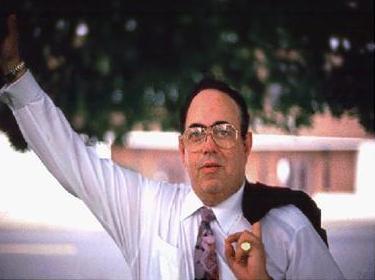
Title
Date
Description
Multiple Available
There are multiple entries on this date. You can modify the date range below to see them all.
MAGI Synthavision
Established Date: Jan. 1, 1972
Deceased Date: July 1, 1986
- All
- animation
- research
- co-founder
- pioneer
- hardware engineer
- software engineer
- animator
- Tron
- Pioneer
- Art Director
-
Begun in 1972 by Robert Goldstein and Bo Gehring, SynthaVision was the software division of MAGI that was marketed commercially for a short time under the company name of Computer Visuals Inc. The original software (Fortran2 and Fortran4 running on an IBM 360/65) used by the MAGI scientists for tracing particle radiation needed to be only slightly modified to trace light rays instead and make .. ta da!: computer graphics. (Well maybe not quite that easily.)
-
In 1975/76 Bo Gehring and others traveled to Hollywood to produce CG tests for Steven Speilberg film Close Encounters of the Third Kind. A film recorder was built by Carl Machover, one of the earliest of it's kind, it used a CRT to expose the imagery onto 35mm film at 4000x2500 lines of resolution. Doug Trumbull also arranged to use a facility in Minniapolis to output to 65mm film. The intent was to realize the spaceships in the end landing …
CE3K tests -
MAGI was a pioneer in putting high resolution computer graphics directly out to film. It's CELCO film recorder (way ahead of its time) was the second ever made. (The first being used by the government for Landsat imagery.
pioneering filmout tech -
An interesting side story that happened about this time concerned another Disney animation project. The Brave Little Toaster was being story-boarded by Lasseter and Jo Ranft, but when Ron Miller (then head of Feature Animation) was ousted, so was the project. For those of you who know the film (and if you have kids you should!) all the characters were household appliances, including a lamp, a radio, and a vacuum cleane - all of whom would have been created in …
Brave Little Toaster -
In 1983-84 at MAGI Ken Perlin developed his now famous "Perlin Noise and Turbulence" techniques of creating solid and procedural textures that are now commonly used everywhere in the CG industry. (It earned him an Academy Award for Technical Achievement in 1997 too).
Perlin makes some noise -
Sythavision's work can be seen in David Cronenberg's, The Fly, where the main character, Seth Brundel plays a visual sequence on his computer that explains that his DNA has been mixed with a housefly. The work is not credited in the film.
'The Fly' on the wall -
The very last project that Sythavision did was a commercial featuring DOW Chemical's Scrubbing Bubbles in their first CG incarnation. These, I'm told, are the same characters that Cranston/Csuri where working on when they folded later. We all watched PDI with interest when they took on Scrubbing Bubbles. Fortunately they survived the curse.
Scrubbing Bubbles curse! -
Synthavision's parent company went out of business in the fall of 1986. Arcca was the reformation of Sythavision staff and software to do the Captain Power television series for Landmark Entertainment. The CAD/CAM division of Magi had been sold to Lockheed Aerospace in 1982/83, while MAGI Computer Slides Corp. was purchased in 1986 from MAGI for $4million and renamed MAGICorp.
The End -
The software techniques were unique in their use of solid modeling techniques. Unlike all other systems, Synthavision used not polygons or patches but "combinatorial geometry" (boolean union, difference and intersection) of mathematically defined solid shapes such as cubes, cones and spheres. For example, a simple flying saucer would be modeled as the intersection of two perfect spheres, and a sphere would never suffer from low resolution straight edged profiles because it is defined mathematically perfect. The raytracing technique, originally developed …
Solid modeling -
John Lasseter (Then a traditional animator at Disney) got his first exposure to computer graphics by working as the official Disney-Magi liason for a joint 1983 post-TRON test for "Where the Wild Things Are". Based on the popular childrens book by Maurice Sendak, the (60sec?) short had a young boy in his pajamas running with his dog up a flight of stairs. The characters were traditional cell animation and the environment was all 3D CG. Disney footed the bill for …
Wild Things -
The Synthavision division was sold off in 1984 to a holding company in Toronto Canada run by Bob Robbins and Leo Grey. The company's new president was David Boyd Brown(Blue Sky). The first main project for Synthavision after the by-out was a laser video disk arcade game called Robot Rebellion which required the player to pilot a small LV1 robot to the core of a mining asteroid to overcome a mine full of crazed robots and booby traps and regain …
Buyout and new owners -
Yes, I directed Worm War One. And yes it had Tron written all over it! Here’s a historical fact. That commercial won the first Cleo award for computer animation! Never before had the Clios had that category until after Tron. Yes, it was done at the Magi Synthavision facility that was in Santa Monica that we built after the completion of Tron. One of the pieces that we did there that was very important, was a test for John Lassiter …
Worm War One - 1st CG Clio! -
 Logo
Logo -
 Bo Gehring
Bo Gehring -
 Robert Goldstein
Robert Goldstein -
 Josh Pines
Josh Pines -
 TRON
TRON -
 David Brown
David Brown -
 Carl Machover
Carl Machover -
 John Lasseter
John Lasseter -
 Ken Perlin
Ken Perlin -
 Eugene Troubetzkoy
Eugene Troubetzkoy -
 Blue Sky Studios
Blue Sky Studios -
 MAGI (Mathematics Application Group, Inc.)
MAGI (Mathematics Application Group, Inc.) -
 Roger Nagel
Roger Nagel -
 Richard Taylor
Richard Taylor
CE3K tests
In 1975/76 Bo Gehring and others traveled to Hollywood to produce CG tests for Steven Speilberg film Close Encounters of the Third Kind. A film recorder was built by Carl Machover, one of the earliest of it's kind, it used a CRT to expose the imagery onto 35mm film at 4000x2500 lines of resolution. Doug Trumbull also arranged to use a facility in Minniapolis to output to 65mm film. The intent was to realize the spaceships in the end landing sequence entirely with CG. In the end, Trumbull favored the traditional approach, and the CG tests were no longer pursued.
pioneering filmout tech
MAGI was a pioneer in putting high resolution computer graphics directly out to film. It's CELCO film recorder (way ahead of its time) was the second ever made. (The first being used by the government for Landsat imagery.
Brave Little Toaster
An interesting side story that happened about this time concerned another Disney animation project. The Brave Little Toaster was being story-boarded by Lasseter and Jo Ranft, but when Ron Miller (then head of Feature Animation) was ousted, so was the project. For those of you who know the film (and if you have kids you should!) all the characters were household appliances, including a lamp, a radio, and a vacuum cleane - all of whom would have been created in 3D CG by MAGI. However Tom Wilhite left Disney and formed Hyperion Animation in order to independently produce the film, and the MAGI work never was to be.
Perlin makes some noise
In 1983-84 at MAGI Ken Perlin developed his now famous "Perlin Noise and Turbulence" techniques of creating solid and procedural textures that are now commonly used everywhere in the CG industry. (It earned him an Academy Award for Technical Achievement in 1997 too).
'The Fly' on the wall
Sythavision's work can be seen in David Cronenberg's, The Fly, where the main character, Seth Brundel plays a visual sequence on his computer that explains that his DNA has been mixed with a housefly. The work is not credited in the film.
Scrubbing Bubbles curse!
The very last project that Sythavision did was a commercial featuring DOW Chemical's Scrubbing Bubbles in their first CG incarnation. These, I'm told, are the same characters that Cranston/Csuri where working on when they folded later. We all watched PDI with interest when they took on Scrubbing Bubbles. Fortunately they survived the curse.
The End
Synthavision's parent company went out of business in the fall of 1986. Arcca was the reformation of Sythavision staff and software to do the Captain Power television series for Landmark Entertainment. The CAD/CAM division of Magi had been sold to Lockheed Aerospace in 1982/83, while MAGI Computer Slides Corp. was purchased in 1986 from MAGI for $4million and renamed MAGICorp.
Solid modeling
The software techniques were unique in their use of solid modeling techniques. Unlike all other systems, Synthavision used not polygons or patches but "combinatorial geometry" (boolean union, difference and intersection) of mathematically defined solid shapes such as cubes, cones and spheres. For example, a simple flying saucer would be modeled as the intersection of two perfect spheres, and a sphere would never suffer from low resolution straight edged profiles because it is defined mathematically perfect. The raytracing technique, originally developed by Bob Goldstein in the late 1960s, evaluated these boolean combinations once per ray. (the key paper was published in "Simulation" in 1968, and is referenced in Turner Whitteds 1981 SIGGRAPH paper which introduced raytracing to a much broader audience). The core math and physics developers at this stage included Herb Steinberg and Dr. Eugene Troubetskoy while Marty Cohen and Larry Elin (a non-scientist and Phil Mittleman's son-in-law too) served in Executive Producer type roles.
Wild Things
John Lasseter (Then a traditional animator at Disney) got his first exposure to computer graphics by working as the official Disney-Magi liason for a joint 1983 post-TRON test for "Where the Wild Things Are". Based on the popular childrens book by Maurice Sendak, the (60sec?) short had a young boy in his pajamas running with his dog up a flight of stairs. The characters were traditional cell animation and the environment was all 3D CG. Disney footed the bill for production, while MAGI paid for the substantial R&D needed to create the hardware and software. Ken Perlin supervised and wrote code for the project. (which also included the now well known Disney animator Glen Keane). Jan Carlee and Chris Wedge modeled the environment and animated the camera move. Christine Chang wrote the digital "ink and paint" software that was used to color the Disney animators scanned in drawings complete with shadow and highlight elements. (A technique used much later to great effect at ILM in Who Framed Roger Rabbit.) Josh Pines built the scanner. This amazing project may have been the first ever example of full feature film resolution CG digital compositing.
Buyout and new owners
The Synthavision division was sold off in 1984 to a holding company in Toronto Canada run by Bob Robbins and Leo Grey. The company's new president was David Boyd Brown(Blue Sky). The first main project for Synthavision after the by-out was a laser video disk arcade game called Robot Rebellion which required the player to pilot a small LV1 robot to the core of a mining asteroid to overcome a mine full of crazed robots and booby traps and regain control of the colony by punching in a color code they learned along the way. Hazards included CG fire created with KPL(Ken Perlin Language) texture code. The finished project had was shopped around to gaming companies like Bally and Atari, but unfortunately occurred as the downturn in arcade gaming began. Like many other computer graphic production companies of the 1980's, Sythavision collapsed under the heavy overhead costs and enormous capital debt of the purchase of the technology.
Worm War One - 1st CG Clio!
Yes, I directed Worm War One. And yes it had Tron written all over it! Here’s a historical fact. That commercial won the first Cleo award for computer animation! Never before had the Clios had that category until after Tron. Yes, it was done at the Magi Synthavision facility that was in Santa Monica that we built after the completion of Tron. One of the pieces that we did there that was very important, was a test for John Lassiter for “Where the Wild Things Are” ! It turned out really well and John wanted to make an animated piece for Disney but they rejected his enthusiasm. Thus, Pixar. There are many interesting stories about that time In the evolution of computer graphics. - Richard Taylor
Begun in 1972 by Robert Goldstein and Bo Gehring, SynthaVision was the software division of MAGI that was marketed commercially for a short time under the company name of Computer Visuals Inc. The original software (Fortran2 and Fortran4 running on an IBM 360/65) used by the MAGI scientists for tracing particle radiation needed to be only slightly modified to trace light rays instead and make .. ta da!: computer graphics. (Well maybe not quite that easily.)
